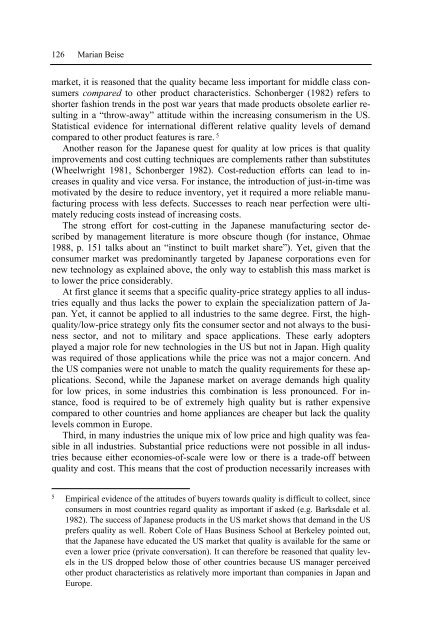Management of Technology and Innovation in Japan
Management of Technology and Innovation in Japan
Management of Technology and Innovation in Japan
You also want an ePaper? Increase the reach of your titles
YUMPU automatically turns print PDFs into web optimized ePapers that Google loves.
126 Marian Beise<br />
market, it is reasoned that the quality became less important for middle class consumers<br />
compared to other product characteristics. Schonberger (1982) refers to<br />
shorter fashion trends <strong>in</strong> the post war years that made products obsolete earlier result<strong>in</strong>g<br />
<strong>in</strong> a “throw-away” attitude with<strong>in</strong> the <strong>in</strong>creas<strong>in</strong>g consumerism <strong>in</strong> the US.<br />
Statistical evidence for <strong>in</strong>ternational different relative quality levels <strong>of</strong> dem<strong>and</strong><br />
compared to other product features is rare. 5<br />
Another reason for the <strong>Japan</strong>ese quest for quality at low prices is that quality<br />
improvements <strong>and</strong> cost cutt<strong>in</strong>g techniques are complements rather than substitutes<br />
(Wheelwright 1981, Schonberger 1982). Cost-reduction efforts can lead to <strong>in</strong>creases<br />
<strong>in</strong> quality <strong>and</strong> vice versa. For <strong>in</strong>stance, the <strong>in</strong>troduction <strong>of</strong> just-<strong>in</strong>-time was<br />
motivated by the desire to reduce <strong>in</strong>ventory, yet it required a more reliable manufactur<strong>in</strong>g<br />
process with less defects. Successes to reach near perfection were ultimately<br />
reduc<strong>in</strong>g costs <strong>in</strong>stead <strong>of</strong> <strong>in</strong>creas<strong>in</strong>g costs.<br />
The strong effort for cost-cutt<strong>in</strong>g <strong>in</strong> the <strong>Japan</strong>ese manufactur<strong>in</strong>g sector described<br />
by management literature is more obscure though (for <strong>in</strong>stance, Ohmae<br />
1988, p. 151 talks about an “<strong>in</strong>st<strong>in</strong>ct to built market share”). Yet, given that the<br />
consumer market was predom<strong>in</strong>antly targeted by <strong>Japan</strong>ese corporations even for<br />
new technology as expla<strong>in</strong>ed above, the only way to establish this mass market is<br />
to lower the price considerably.<br />
At first glance it seems that a specific quality-price strategy applies to all <strong>in</strong>dustries<br />
equally <strong>and</strong> thus lacks the power to expla<strong>in</strong> the specialization pattern <strong>of</strong> <strong>Japan</strong>.<br />
Yet, it cannot be applied to all <strong>in</strong>dustries to the same degree. First, the highquality/low-price<br />
strategy only fits the consumer sector <strong>and</strong> not always to the bus<strong>in</strong>ess<br />
sector, <strong>and</strong> not to military <strong>and</strong> space applications. These early adopters<br />
played a major role for new technologies <strong>in</strong> the US but not <strong>in</strong> <strong>Japan</strong>. High quality<br />
was required <strong>of</strong> those applications while the price was not a major concern. And<br />
the US companies were not unable to match the quality requirements for these applications.<br />
Second, while the <strong>Japan</strong>ese market on average dem<strong>and</strong>s high quality<br />
for low prices, <strong>in</strong> some <strong>in</strong>dustries this comb<strong>in</strong>ation is less pronounced. For <strong>in</strong>stance,<br />
food is required to be <strong>of</strong> extremely high quality but is rather expensive<br />
compared to other countries <strong>and</strong> home appliances are cheaper but lack the quality<br />
levels common <strong>in</strong> Europe.<br />
Third, <strong>in</strong> many <strong>in</strong>dustries the unique mix <strong>of</strong> low price <strong>and</strong> high quality was feasible<br />
<strong>in</strong> all <strong>in</strong>dustries. Substantial price reductions were not possible <strong>in</strong> all <strong>in</strong>dustries<br />
because either economies-<strong>of</strong>-scale were low or there is a trade-<strong>of</strong>f between<br />
quality <strong>and</strong> cost. This means that the cost <strong>of</strong> production necessarily <strong>in</strong>creases with<br />
5 Empirical evidence <strong>of</strong> the attitudes <strong>of</strong> buyers towards quality is difficult to collect, s<strong>in</strong>ce<br />
consumers <strong>in</strong> most countries regard quality as important if asked (e.g. Barksdale et al.<br />
1982). The success <strong>of</strong> <strong>Japan</strong>ese products <strong>in</strong> the US market shows that dem<strong>and</strong> <strong>in</strong> the US<br />
prefers quality as well. Robert Cole <strong>of</strong> Haas Bus<strong>in</strong>ess School at Berkeley po<strong>in</strong>ted out,<br />
that the <strong>Japan</strong>ese have educated the US market that quality is available for the same or<br />
even a lower price (private conversation). It can therefore be reasoned that quality levels<br />
<strong>in</strong> the US dropped below those <strong>of</strong> other countries because US manager perceived<br />
other product characteristics as relatively more important than companies <strong>in</strong> <strong>Japan</strong> <strong>and</strong><br />
Europe.


